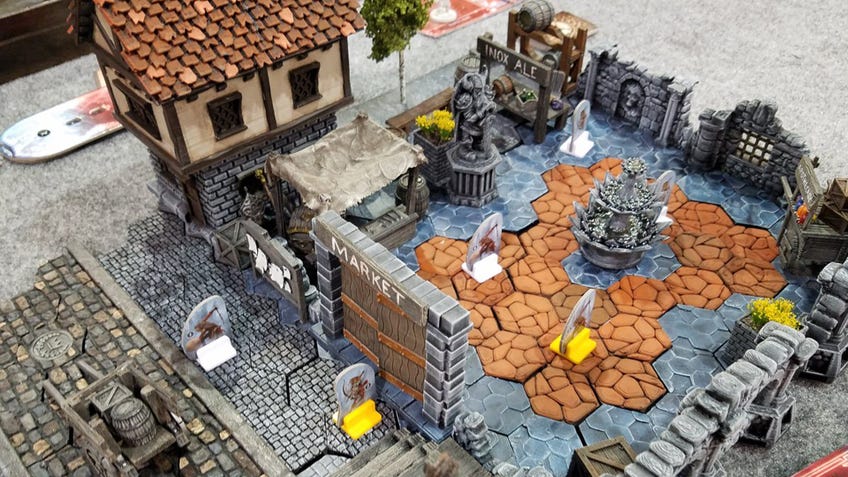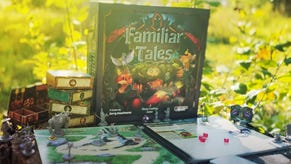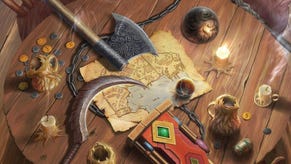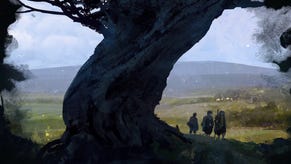How to play Frosthaven: setup, character creation and rules explained
Face many dangers while protecting your base in Frosthaven.
If you’re looking for a board game where you and some friends take on the role of mercenaries and progress through a whole campaign in a medieval fantasy setting, then Frosthaven is the right pick for you.
As the successor of Gloomhaven, this game presents a complex system that allows players to live a whole adventure filled with missions to be completed and treasures to be found. Each player controls a character who has their reasons to be facing the many dangers around the outpost of Frosthaven. Will your mercenary persevere and survive this adventure or perish in the freezing lands of Frosthaven?
How to play Frosthaven
- Player count, game length and overview
- Setup
- Character creation
- Scenario Setup
- Outpost setup
- Scenario gameplay
- Outpost gameplay
- Ending the game
In this guide, we cover the basic rules related to scenarios and outpost phases. However Frosthaven is a quite dense game with plenty of combat and character progression mechanics. Though the explanation you will find will be enough to give you a solid idea of how to prepare for your session and understand how to progress through each phase, you will inevitably need to consult the game’s official rulebook at some point.
Player count, game length and overview
Frosthaven is a dense experience where you play as a group of mercenaries who set out on a journey to complete the game’s main campaign. Besides the narrative aspect of the game, there is also the tactical combat in each mission - making every session a unique event.
The game is intended to be played by a group of two to four players, although there is a special set of rules in case you want to play it solo. This is a game where each session might take from 90 to 120 minutes to complete one scenario, while finishing the whole campaign, which has over 100 scenarios, could take several months.
Setup
Setting things up to play a session of Frosthaven is a process that will require preparing the right pieces for the two main gameplay modes you’ll be playing. There is the scenario setup - elements utilised to organise the missions you go on through the campaign - and the outpost setup, where you go between scenarios. But, before you prepare these two, you must first create everyone’s characters.
Character creation
When starting the campaign, players must choose their character’s classes from the six starting ones: Banner Spear, Drifter, Boneshaper, Deathwalker, Blinkblade, and Geminate. In Frosthaven, there are more classes to play with, but players need to unlock them during the campaign. At the same time, players can’t play using the same class.
Once every player has chosen their class, they must get one small box and one medium box that have the symbol of the class they have chosen. In the small one, they will find a miniature to use during the scenarios, while in the other box there will be the following items:
Character Sheets: Each player will use one of these sheets to keep a record of changes, as well as keep track of all basic information regarding their characters.
Character Mat: This is a small card where players find an illustration and other important pieces of information, such as their hand size number.

Character Standee: This works as an alternative for the miniature.
Summon Standees: Only used with characters who have abilities that can summon allies into scenarios.
Character Tokens: Used to track character’s abilities.
Initiative Order Token: This one is going to be placed in order of initiative with other players’ and monsters’ tokens during a scenario to represent the order actions are going to be taken.
Ability Cards: These are used to represent abilities and other types of actions characters can perform.
Advanced Attack Modifier Cards and Perk Remind Cards: These are only used when characters level up. You should check the rulebook to know more about this process that happens during the outpost phase.
Players must pick from the purchasable supply list of items - equivalent to items number 120 to 128 in the rulebook - to be the pieces of equipment they want to start with. Each player begins with a total of 30 gold to spend on items during character creation and any remaining gold is lost after it, so be sure to use as much as possible.
There is one last step in the character creation process. After all these pieces are correctly distributed, each player should draw two cards from the personal quest deck, keep one and shuffle the other back. Personal quests are used to explain the reason for a character to come to Frosthaven and it must be kept secret. Maybe the character is looking for a missing family member or wants to challenge a fierce adversary! Once this quest is completed, the character is retired and the player must create a new one.
Scenario setup
To begin playing Frosthaven, players must first go through scenario zero and scenario one. Whenever you’re beginning a new scenario, you must first check its entry in the scenario book. There you will find:
The goal for the scenario and any special rules.
The map tiles showing the initial rooms you will place for the scenario and what monsters and environment elements - overlay tiles - must be placed on them.
All the information players need to know once they have unlocked the scenario and if they meet the’ basic requirements required to play it.
A list of all the loot players will find.
Once you understand all the basic details regarding the scenario, you must prepare the materials you will be using. Put the loot deck together based on the list on the scenario entry, get the modifiers deck, additional track modifier cards and the stat cards in the stat sleeves to show only the relevant stats.
You must prepare the rooms according to what is shown in the scenario entry, positioning loot markers, environment elements, monsters and all players’ characters. The miniatures or stands of each character must occupy only one hex each and, at the beginning of a scenario, they must be placed in one of the starting hexes which are indicated by an entrance sign.
Before your party begins playing the scenario, each one must also go through a few steps. First, pick the items they are taking with them and apply any negative effects and/or start-of-scenario effects they have. After that, they must also choose the ability cards they are going to use during this scenario. They can take a number of cards equal to what is shown in their character’s mat, below their portrait. For the first scenario, players should only use level-one ability cards.
Players should also draw three cards each from the battle goal deck, keep one and discard the other two faced down. The goals must not be shared among players and, in case they are met, players get the rewards only if the scenario is completed. Positioning each player’s character mat in front of them is also helpful in order to organise things such as the discard pile and lost pile.
Outpost setup
To play the outpost phase, there are a few elements you should have with you.
The Map Board: This is a map showing not only Fronsthaven but also other lands where the scenarios will unfold. Whenever a scenario or building is unlocked, you can affix the corresponding sticker on this map.
Scenario Flowchart: In this flowchart, players will find all the scenarios and an overview of which ones they are connected to. After completing the initial scenarios, whenever a new scenario is unlocked, you must open the corresponding window on this flowchart, where you’ll find a sticker representing the new scenario.
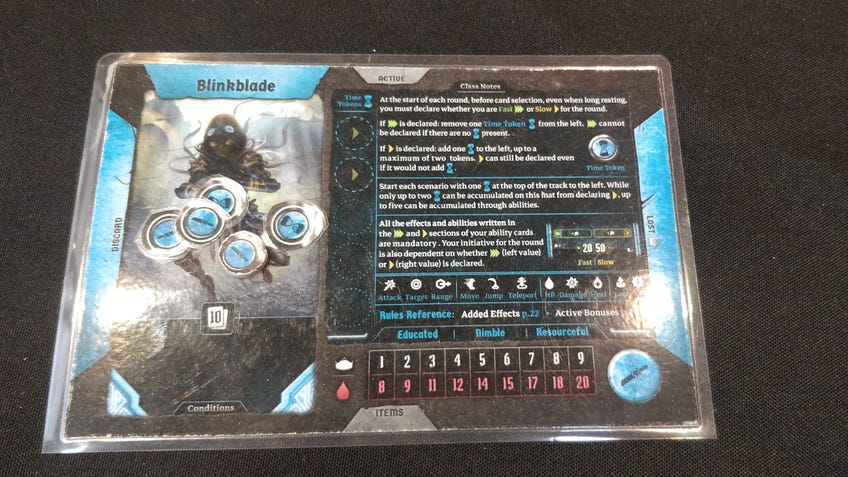
Campaign Sheet: Just like a character sheet, the campaign sheet has all the important information regarding the Frosthaven outpost you need to keep track of, such as the campaign calendar, Frosthaven supply, soldiers, inspiration value, total defense value, morale track, retirement table, town guard perks and prosperity track. All of these are detailed in the rulebook.
Town Guard Deck: This is a deck with 20 cards at the beginning of the campaign. These cards are used during special outpost events where Frosthaven is attacked.
Gameplay rules
Considering there are two different gameplay modes players will find themselves in Frosthaven that require two different setups, there are also two specific sets of rules for scenarios and for the outpost.
Scenario gameplay
During scenarios, characters will basically explore the location and engage in battle with creatures. To learn specifically about all the types of actions and a more detailed explanation about abilities, don’t forget to check the official rulebook. A round during a scenario is split into four phases:
Card Selection: Each player selects two ability cards from their hand and places them face down. They will choose one of these cards as their initiative card. Keep in mind that the official rules specify that players can’t talk about their cards, only about what they intend to do. For example: instead of saying you have a low initiative value and that you will act first to deal five points of damage to the ice troll, you should tell other players that your plan is to look for a chance to attack the troll. In case this is not the first round and you have at least two cards in your discard pile, you can choose to have a long rest instead of selecting a card and playing this round. You will be the last one to act - initiative of 99 - but, by having a long rest, you can pick one card from your discard pile to remove for this scenario and retrieve all the others, as well as heal two hit points and recover all spent items.
Ordering of initiative: At the beginning of this phase, players will show only their initiative cards as well as draw the monsters’ cards to check their initiative value. In players’ cards, this value is the number at the center of it. After that, place the order tokens from the lowest value – at the top – to the highest value – at the bottom – to represent the order players and monsters will have their turns
.Characters and Monsters turn: Now that you know the order players and monsters will act, it’s time for each one to have their turn. In character turns, players need to use the two cards selected early in the round. Every card has one action at the top half and a different one at the bottom half. Players have to choose the top action of one card and the bottom action from the other one. While it doesn’t matter the order they are picked, they can’t be on the same part of their cards. In case one of the halves has two abilities separated by a line, they are resolved from top to bottom. Once the actions are resolved, the cards must be placed in the discard pile - left side of the characters mat -, although some ability cards with power actions end up directly in the lost pile. But, when it comes to monster turns, they will resolve the actions in the monster ability cards drawn in the first phase. In the case of individual monsters, players should take into consideration the monster’s stat card. Monster ability cards that have already been resolved go to a discard pile after their turn is complete.
End of round: Once every character and monster has gone through their turn, the round ends. In case players have at least two cards in their discard pile, players have the chance of having a short rest now. By doing so, they can retrieve all cards from their discard pile, but one which must be randomly chosen and put into the lost pile.
When once you have completed a scenario and it’s not specified you must start the next scenario right away, with players able to choose to go to the outpost.
Outpost gameplay
There are five phases in the outpost round in which players manage the place and can prepare themselves for the next scenario . Not everything about this mode will be outlined here, so be sure to check the official rulebook. The basic outpost phases are:
Passage of time: Mark on the calendar in the campaign sheet that one week has passed. When 10 boxes on the calendar are filled, the season changes, determining which deck of road and outpost events you will draw from. To know more about these specific cards, check the rulebook.
Outpost Event: Draw a card from the outpost event related to the season you’re in. Some of these cards will depict an attack event, which is related to a set of rules specific to this mode.
Building Operations: In this phase, you go through the building deck and resolve normal effects. There are also wrecked effects in case any buildings have been damaged during the previous phase.
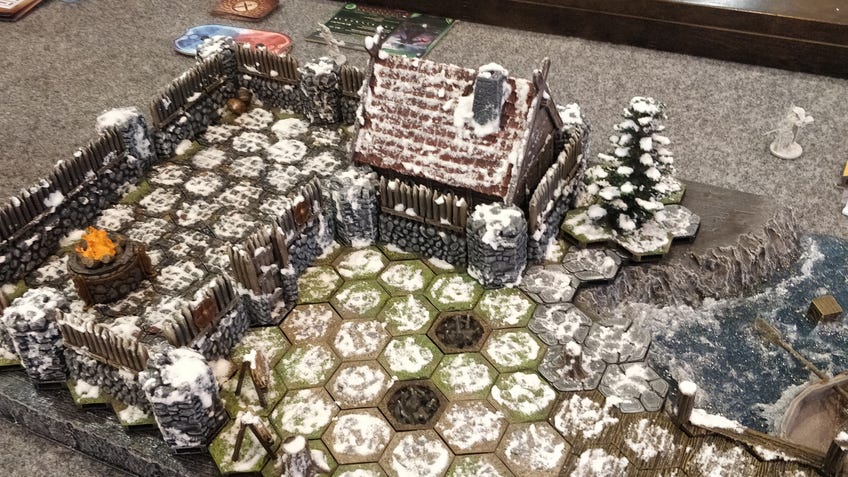
Downtime: It’s in this phase that players can perform certain actions, such as level up, retire a character, create a character, craft items, brew potions and sell items. Each of these is tied to specific gameplay mechanics explained in the rulebook.
Construction: If you have unlocked a new building or want to upgrade/rebuild another one you already have, this is the moment to do so. By default, only one building can be built, upgraded or rebuilt. In the case you want to perform the same action to a second build, you will lose two morale points.
Once all characters have gone through any activities in the outpost, it’s time to keep up the adventure and go to the next scenario!
Ending the game
While a scenario is completed by reaching its goals, finishing one is hardly the end of the game. To finish Frosthaven, your party must go through all scenarios needed to complete the campaign.
